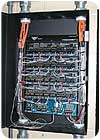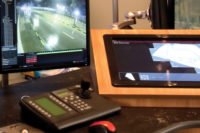
The marking B14 means that this cable goes to the 14th door in the centrifuge building.

Kevin Morgan, senior project manager for United Automation, terminates cables into a control panel box at OB Curtis. More than 100 card readers and other devices were installed here.
When United Automation, West Monroe, La., began working on an access control project for OB Curtis, a water treatment facility in West Monroe, La., those at the company and Siemens Building Technologies, Buffalo Grove, Ill., general contractor for the project, knew they needed a high degree of cable organization for the job.
The facility has 11 buildings with a total of 72 doors. Each door contained a request to exit, lock and door contact. In addition, more than 100 card readers and other devices needed to be installed.
“The biggest challenge for the OB Curtis installation was that it was an existing facility with several buildings,” explains Kevin Morgan, senior project manager. “There was one controller but multiple doors. For this installation, it was crucial to find the necessary tools to organize this job completely.”

Each door at OB Curtis, a water treatment facility, consists of a request-to-exit, lock and door contact.
Having used the SmartWire system design tool from Windy City Wire, Cable and Technology Products LLC, Hillside, Ill., in the past, Morgan sent the compiled list of doors and devices to a company representative.
“Developing an effective labeling and color code scheme was needed, and we were able to do this using the design tool,” Morgan says. “Each element and device was designated by a specific color stripe on the cable, which allowed for quick and easy identification. The print legends on the cables were then used to identify each building, as well as the doors. It resulted in a clean installation.”
SmartWire is a low-voltage wire and cable product that acts as tape measure, toner, tester, label maker and ultimately a time-saver because of its features.
The system design tool is a software program that allows an integrator to design and create a job plan, thereby enabling field technicians to perform at their maximum productivity levels.

The OB Curtis facility consists of 11 buildings with a total of 72 doors.
The second step was to establish all the origins and destinations of the cables. This meant that United Automation had to determine the start of the cable, where the controller was and the end of the cable, where it is terminated.
All of this information was necessary to create wire tags for this installation. The next step was to create a marking and labeling scheme using the design tool.
“Each building was marked using the Alpha A-E print legend on the cable,” Morgan explains. “Each door was marked using the numerical coding.”
The four-element access control cable, consisting of lock power, card reader, door contact and request-to-exit, was the cable of choice for the installation.
Besides having the advantage of making one cable pull instead of four, the outer jacket of the four-element access control cable features yellow for plenum and orange for non-plenum cable. It also provides extra protection to the inner elements from the damage that could result during the installation process.

Four-element cable is terminated to a control panel at OB Curtis.
The next step in the planning process was to establish the customized wire tags using the design tool. Not only were the integrators able to increase field productivity with the use of these features, but the customized wire tags also simplified identification.
All boxes and spools arrived with the system to identify the applications, devices, locations and addresses needed to complete each individual job, as well.
Overall, the design tool enabled United Automation to identify applications, apply devices, pick cables, identify locations and create a marking and labeling scheme with a few clicks on Windy City Wire’s Web site.
“The System Design Tool was great for a job like this one, which had one controller and multiple locations,” Morgan emphasizes. “It really helped us to stay organized.”
Sidebar: On the Job
From Windy City Wire, Cable and Technology Products LLC,www.smartwire.com
- SmartWire System Design Tool
- SmartWire four-element access control cable
Sidebar: PROJECTS in the News
The MESH system fromViscount Systems Inc., Burnaby, British Columbia, is being installed at a large multi-building campus and gated complex in Los Angeles. The equipment order shipped for the first phase was in excess of $50,000. The system includes MESH panels, servers, RFID readers and long-range vehicular readers networked across the multi-acre site.A large, high-security government agency in the Washington, D.C., area contracted withMDI Security Systems, San Antonio, Texas, and Global Systems Solutions (GSS) to secure its facilities in a project worth more than $1.3 million to MDI. At press time, during the first quarter of 2007, the project was being staged and executed. The customer requires the highest degree of unified access control, intrusion detection management, and integrated security management available. The agency is also part of several international governmental organizations that share their research to identify security improvement efforts that meet mandated requirements related to Homeland Security Presidential Directive 12 (HSPD-12), Federal Information Processing Standard 201 (FIPS 201) and the Personal Identity Verification (PIV) of federal employees and contractors.
Harrod’s of London has chosen the TUB camera from the French manufacturerTEB. The two TUB camera systems are covering the store’s entire warehouse. Complete coverage of the warehouse is achieved with only two cameras moving backward and forward within the TUB tubular housing. The shuttle camera moves at speeds of up to 6 meters per second and can be operated from the TEB Neopad controller or from an existing control system.

